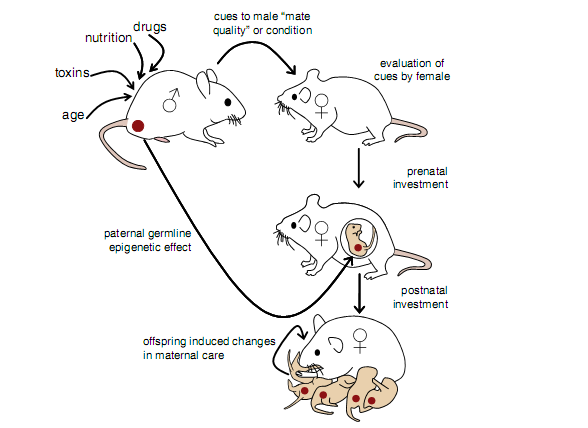
The last two decades have been marked by considerable strides in the field of genetics, which culminated in the mapping of the human genome in 2003. However, as scientists continued to uncover how genetics go about influencing physiological and psychological characteristics, they discovered that not all inheritable characteristics have their basis in the traditional Mendelian fashion of genetic transference. For instance, it was found out that although some diseases may have a genetic basis, they may or may not manifest based on specific markers that are responsible for silencing or activating genetic variations.
AI-content Free
This has to lead to widespread research in a recently new field of genetics called epigenetics. This paper will discuss the epigenetics and identical twins’ positive behavior motivational plan, which entail differences in attitudes, emotions, personalities, and values. The essay paper will include diagrams and examples to enable a clear understanding of identically different views on epigenetics and identical twins.
Epigenetics is the study of how changes in both the internal and external environment of an organism may bring about changes in gene expression without necessarily causing genome mutation. These changes manifest in the cells and body of an organism and in some instances may be hereditary (Ito, 2009). The process is depicted in Figure 1, where the paternal germline is depicted as carrying epigenetic material which is transmitted to the subsequent generation (Curley, Jensen, Mashoodh, & Champagne, 2010). However, the process may involve both paternal and maternal germlines. Epigenetics concerns itself with studying the mechanisms by which these changes come about. It may help explain why cell differentiation occurs despite the fact that all cells possess a complete set of genes in the strands of DNA found within the cell nucleus (Haig, 2006).

Figure 1. Epigenetic changes in the paternal germline of being carried over to subsequent generations (Curley et al., 2010).
Historically, the term epigenetics was first used by Conrad Waddington in 1942 (Haig, 2006). However, the word did not fully convey the concept of epigenetics, as we know it now. Waddington coined the word in an attempt to explain the concept of causal mechanisms through which phenotypic effects relate to the genes of the genotype. He put across the concept of genetic assimilation, a mechanism through which a specific character could be inherited. Through this concept, he was able to assign a role to the environment as a key factor in an organism’s development process (Haig, 2006).
According to Haig (2006), in 1958, another pioneer in the field of epigenetics was Nanney, who helped develop the field further. He developed a definition of epigenetics that is closer to the modern use of the term. Nanney used the term in reference to cell hereditary processes that were not dependent on replication of the double helix strands of DNA through a template-replicating process (Haig, 2006). Other researchers and scientists helped shape the field of epigenetics. Examples include the discovery of genetic transposition in maize, a discovery was made by McClintock in the 1940s. This discovery was important since it demonstrated a very clear cut instance of paramutation, a notable case of non-mendelian hereditary inheritance (Brink, 1956). Such inheritance was thought to be peculiar to the maize plant until similar effects were realized on the mouse during genetic experiments. According to Rassoulzadegan et al. (2006), the study was the first complete report on how hereditary mechanisms in mammalian organisms can resemble paramutations typically found in the plant kingdom.
Epigenetics has been defined as the study of inheritable changes in genetic function without necessitating changes in the underlying DNA sequence. There currently exist two paradigms that seek to explain how epigenetic changes take place. These paradigms are the polycomb and trithorax system and the DNA methylation system (Bird, 2007). The first system involves groups of proteins called the polycomb and trithorax protein groups which are thought to play two key roles in maintaining either an inert or active state of various genes important in an organism’s development process. The two groups of proteins were named after subspecies of the fruit fly whose scientific name is Drosophila melanogaster.
Book The Best Top Expert at Top-papers.com
Your order will be assigned to the most experienced writer in the relevant discipline. The highly demanded expert, one of our top-10 writers with the highest rate among the customers
Hire a TOP Writer for 4.40 USD


Furthermore, studies conducted on the fruit fly displayed the role the two protein groups play in activating or repressing specific genetic variations (Curley et al., 2010). However, it emerged that such patterns could not be maintained for long. The polycomb and trithorax system is therefore assumed to be concerned chiefly with memorizing gene expression processes that have their origins in other cellular mechanisms (Bird, 2007).
Evidence presented by Cavalli and Paro (1998), suggests that the polycomb protein group, which is involved in gene silencing or inactivation is hereditary in subsequent fruit fly generation although at a very low level of occurrence. The second paradigm involved DNA methylation, which is informed by biochemical studies that preceded the conceptualization of the epigenetic system. During the process of DNA methylation, a methyl compound is added covalently to the fifth carbon within the cytosine ring, forming 5-methyl cytosine (Kaminsky et al., 2009). This process usually takes place in CPG sites composed of cytosine linked to guanine by a phosphate.
DNA methylation actively regulates cell function and differentiation. Closely related to DNA methylation is the process of histone modification (Weksberg et al., 2002). Histones are protein groups that make up the nucleosome together with DNA. The role of histones is to determine how the chromatin is compacted during the gene transcription process and therefore determine whether specific genes are transcribed. Enzymes can catalyze histone modification by adding or removing molecules like phosphates or acetyl or methyl groups. Histone modification can cause random gene expression and may even lead to diseases.
Studies comprising twins play a major role in assessing heritability, which is an estimate of genetic contributions to variations of phenotypes within a given population. This is because the similar genes carried by the twins allow for other less obvious influences and mechanical mechanisms involved in bringing about a phenotypic variation to be explored. Studies involving both Monozygotic and Dizygotic twins may shed some light on the role that epigenetics and other hereditary mechanisms operate (Petronis, 2006).
Free Features
Cover/
Title Page
References/
Bibliography List
Table of Contents
Abstract
Outline
(on demand)
According to Haque, Gottesman, and Wong (2009), monozygotic twins possess similar genomes while dizygotic twins have only half of their segregating DNA in common. This means that the role genetic factors play in manifesting specific traits is two times the rate of concordance existing between monozygotic and dizygotic twins (Petronis, 2006). Monozygotic twins who display phenotypic differences are usually indicators of the role the environment plays in phenotypic variation (Haque, Gottesman, & Wong, 2009).
According to Petronis (2006), identical twins provide the ideal subjects for studies on the role the environment plays in epigenetics since similar DNA sequences rule out genetic variations. Such genetic variations would be abundant in singleton-based studies. Monozygotic twins offer the greatest potential in such studies, and such studies have been carried out successfully (Petronis et al., 2003). For instance, differences in DNA methylation were shown to be responsible for an imprinting defect that led to the development of the beck with Wiedemann syndrome in a set of monozygotic twins (Haque, Gottesman, & Wong, 2009).
The study was able to shed light on the rare syndrome which could not have been studied under traditional epidemiology due to the nature of pathological events that take place during the early phases of embryogenesis. Molecular epigenetics was utilized to identify the molecular defect responsible for the defect as well as highlighting the specific mechanism responsible for it, that is, the incomplete DNA methylation process during a vital stage of pre-implantation during embryonic development (Kaminsky et al., 2009).
Original writing according to your instructions
Deadlines from 3 hours to 60 days
All disciplines covered
Confidentiality
24/7 Support
Plagiarism-free papers
Timely delivery
Skilled writers with Master’s/PhD degrees
Personal data security
Instant replies to all your questions
Another study focused on differences in the localized DNA methylation process in monozygotic twins has identified these differences as key in regulating the genes encoding dopamine receptors (Kaminsky et al., 2009). A study by Fraga et al. (2005), focused on locus-specific as well as global differences of histone modification and DNA methylation within a group of 40 identical twins within the age ranges of 3 to 74 years. The study was able to show a correlation between age and epigenetic changes among the twins. An interesting outcome of this study was the fact that close to two-thirds of the twins tested displayed similarities in epigenetic patterns. From this correlation, one can infer that epigenetic similarities may contribute to phenotypic similarities in the same way that epigenetic differences lead to phenotypic variations.
Epigenetic similarities are higher in monozygotic twins than in their dizygotic counterparts. Similarities also exist in specific mRNA levels in monozygotic twins (Petronis et al., 2003). The epigenetic differences in dizygotic twins could be a result of differences in DNA sequence (Fraga et al., 2005). Studies of epigenetic variations in monozygotic twins may help identify specific epigenetic markers and their effect on phenotypes (Petronis et al., 2003). Such studies would involve both monozygotic and dizygotic twins and could establish cause and effect relationships between phenotypes and epigenetic variants.
In conclusion, studies involving singletons would help clarify the effects of various epigenetic markers that could be independently verified in discordant twins studies and epigenetic heritability.
Monozygotic or identical twins sometimes display phenotypic differences which can be attributed to intrauterine environmental factors. The degree of phenotypic difference may vary. Such phenotypic differences touch on a variety of traits from physical attributes such as facial features to complex behaviors and even diseases (Wong, Gottesman, & Petronis, 2005). Monozygotic twins arise from a split in a single fertilized ovum during embryogenesis (Haque, Gottesman, & Wong, 2009). The split results in the development of two or more individuals who have a common gametic origin and therefore have identical DNA sequences (Kaminsky et al., 2009). However, such twins end up displaying phenotypic differences during later periods of their lifetimes (Haque, Gottesman, & Wong, 2009).
Make the right choice and get the
TOP quality papers

According to Reiss et.al (1991), such phenotypic differences are a result of environmental factors that act on the individuals directly and at different rates. However, this conclusion is not widely accepted since a number of studies have investigated the rate of environmental factors in monozygotic twins raised in a common environment as well as those raised apart (Petronis et al., 2003). These studies have found that environmental influences are inadequate in wholly explaining the differences that exist in the cases studied (Bouchard, Heston, Eckert, Keyes, & Resnick, 1981). According to Bouchard et al. (1981), differences in epigenetic patterns exhibited by the twins may be responsible for observable differences in phenotypes despite the twins sharing a common DNA sequence.
According to Gordon et al. (2011), discordance at the birth of monozygotic twins is controlled by factors of epigenetics which include histone modification and DNA methylation. The differentiation is associated with epigenetic changes that are coordinated during the early stages of life for the mice embryo. The result of the differentiation is cells ensuing leading to the profile of epigenetic and characteristic expression of genes for its tissues (Gordon et al., 2011). The partial stability shown by DNA methylation is attributed to hormones, programs of developmental, stochastic events, and the environment (Kaminsky et al., 2009). MZ twins have a stratification of the epigenome that is functionally associated with the division of cells. The MZ twins have epigenetic differences because the DNA sequence does not fully determine the profiles of epigenetic. Epigenetic discordance between MZ twins samples is higher than technical replicates that belong to a provided biological sample that is the same. Individuals who are genetically-different have larger median discordance in comparison to MZ twin pairs. It ascertains, there is an influence in gene expression by the differences that occur in an environment that is intrauterine and in genetics (Kaminsky et al., 2009).
Cases of gene classes and discordant genes that are highly prone to phenotypic discordance focus on mainly birth weight and chorionic city. A gene test by Wilcoxon rank-sum, which is a consistency statistical test, proves that twin pairs for the same genes exhibit across all pairs within-pair discordance (Kaminsky et al., 2009). This occurs regardless of the phenotypic differences. According to Kaminsky et al. (2009), adult twin pairs that are not discordant because of phenotype varies within white blood cells less than the genes associated with cell division, cell development, immune response, cellular transport, and proliferation. Monozygotic twin’s phenotypic dissimilarities can be more understood through epigenetic strategies, derived from complex diseases of non-mendelian features and dysfunctions of epigenetic mechanisms (Petronis et al., 2003).


Exclusive savings! Save 25% on your ORDER
15% OFF your FIRST ORDER (with the code toppapers15) + 10% OFF every order by receiving 300 words/page instead of 275 words/page
According to Petronis et al. (2003), MZ twins who have been brought up together and MZ twins who have been brought up apart have phenotypic differences with a similar degree paradox. Epigenetic regulation helps explain the similarities through the stochastic events. In early embryogenesis, organisms exhibit epigenetic status that is quite similar. In late adolescence, monozygotic twins experience accumulated epigenetic dissimilarity. In the study, there are varying differences in epigenetic signals of somatic mosaicism across the tissues, individuals, DNA bisulfite-modified, and genes (Petronis et al., 2003). There exist nonuniform patterns that are methylation across the bisulfite-modified DNA within different and same individuals. The test for schizophrenia for discordant and concordant pair of monozygotic twin reveals that the affected discordant twin is epigenetically closer to the affected concordant twin than the monozygotic unaffected co-twin (Petronis et al., 2003).
In conclusion, epigenetic discordance among the monozygotic twins is attributed to the expression of discordance and phenotypic differences caused by differences in the intrauterine environment. Within pairs, there is a variable expression for genes involved in external environment response, where cell type is independent.
Unraveling complex epigenetic issues for MZ twins relate to investigating the genotypes and phenotypic discordance types. The epigenetic difference is associated with the disease’s susceptibilities and anthropomorphic features (Fraga et al., 2005). According to Fraga et al. (2005), analyzing the histone acetylation and the DNA methylation differences of the monozygotic twin’s cohort, which is locus-specified and global, will assist to address the issue of the existence of MZ twins complex epigenetics (Bouchard et al., 1981). Different phenotypes in MZ twins can be derived from genotype that is the same.
Share our service with your friends and
get 10% from every order they place
Uses of monozygotic twins lead to births and independent development caused by a single zygote going through mitotic divisions for its two daughter cells or more. Hereditary factors play a role in psychiatric diseases due to MZ twin’s concordance rates that are higher (Petronis et al., 2003). The most challenging question for diseases of complex non-Mendelian is the MZ twin’s incomplete concordance between them. One of the MZ twins may have a disease that is clinical, while the other is not because of environmental effects that are non-shared (Haig, 2006). According to Petronis et.al (2003), the disease differential susceptibility for each of the MZ twins who are genetically identical is a complex molecular cause that needs clear analysis. An investigation of pairs of MZ twins for the DNA modification for the gene (DRD2) of dopamine D2 receptor concludes that there exist differences in epigenetics for MZ twins (Petronis et al., 2003). The epigenetic variation for MZ twins discordance is a source of putative molecular substrates.
Experiment to unravel complex epigenetic issues: two MZ twins are selected from 66 pairs who are psychoses affected. One twin from the first pair is diagnosed with schizophrenia at an earlier stage of 22 years, and the co-twin is unaffected for 6 years. The twins from the second pair are diagnosed with schizophrenia disease at the early stages years of 17 and 19 ages (Petronis et al., 2003). In the end, the affected twins were diagnosed with schizophrenia which is an undifferentiated type. Somatic mosaicism developed in the patterns of DNA methylation when two clones from DNA bisulfite-treated are the same for a cytosine. MZ twins study using restriction enzyme methylation-sensitive suggesting that RLGS (Restriction Landmark Genome Scanning) is caused by differential modification of epigenetics (Petronis et al., 2003). The DNA predisposing disease, environmental factors that are hazardous, the activity of genes epigenetic dysregulation contribute to psychoses etiopathogenesis (Haig, 2006).
The feature of complex diseases for the non-Mendelian variety fits well with the mechanism of dysfunction epigenetic. The DNA sequences remain stable in the organism’s lifetime, but chromatin and DNA methylation have processes that are dynamic. Chromatin and DNA methylation are types of epigenetic mechanisms. These issues of gene activity of epigenetic regulation are subjected to a specific tissue, dependent on age, induced environmental, stochastic events changes, and stage development (Haque, Gottesman, & Wong, 2009). This means that epigenetic dissimilarity and expression of differential genes can accumulate in two different identical organisms that are genetically in their cells within the same tissue i.e. brain. Discordant MZ twins analysis in the epigenetic studies is used for investigating Beckwith-Wiedmann syndrome (BWS) (Weksberg et al., 2002).
 VIP
services
VIP
services
According to Fraga et al. (2005), in the early years, MZ twins are epigenetically indistinguishable, but older MZ twins in 5-methylcytosine DN genomic distribution and acetylation histone have a remarkable difference. These affect the gene-expression portrait for the MZ twin due to the complex epigenetic issues. To understand the MZ twins study, the discordant skewing for X-linked disease can help determine the difference for females inactivation of the X chromosome from MZ twins epigenetic layers, the pattern for not associated with clinicopathological and epidemiological feature (Fraga et al., 2005). This suggests that epigenetic discordance for Monozygotic twins can start early during their development (Kaminsky et al., 2009). During the early and older ages, MZ twins have changes in DNA methylation patterns where there is ample presence of hypomethylation and hypermethylation events. The epigenetic information is stored by histone and DNA methylation which controls gene expression heritable states (Bird, 2007). Evidently, epigenome varies in different tissues, although various cells of the complex organisms have uniform genomic information.
Epigenetic modification patterns diverge in older ages for MZ twin pairs. Furthermore, a difference in patterns of epigenetics for individuals genetically identical is a result of internal and external factors influence (Bouchard et al., 1981). These external factors influencing the differences are physical activities, the diet of the organism, and the habits of smoking. Additionally, epigenetic information transmitting defects of cell divisions are caused by the aging of an organism which influences the epigenetic pattern differences, also called epigenetic drift (Fraga et al., 2005).
In conclusion, MZ twins use to offer an effective platform to unravel the complex genetically identical individuals’ differences. The models offer a basis for the study of roles and contributions of modifications of epigenetics during the formation of a phenotype. A third of MZ twins harbor differences in epigenetic patterns for histone modification and DNA methylation. MZ twins have repeat DNA sequences due to differential markers distributed in their genomes. The markers are distinct in older twins whose lifestyles are different and who live differently, thus concluding that environmental factors are involved in genotype translation to a phenotype that is different. Finally, the epigenetic difference plays a role in the discordance of MZ twins during the onset.





